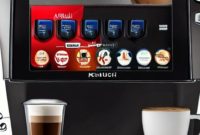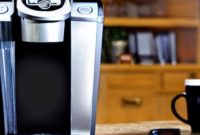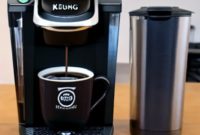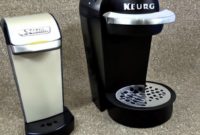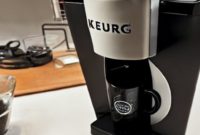Keurig 2.0 coffee machines are popular and often filled with water and coffee grounds that can build up over time, leading to poor performance. In this blog post, we provide 10 tips to keep your Keurig running smoothly. Follow these simple steps and you’ll be enjoying fresh cups of joe in no time!
Table of Contents
1. Make sure your water reservoir is full
The water reservoir in your keurig contains the coffee and water that makes your k-cups work. Over time, residues from these ingredients will build up and cause problems with the machine
- Clean the inside of the brewer every two weeks
- Descale using a special K-Cup descaler
- Keep beans fresh by storing them in an airtight container
- Avoid overfilling your brewer
- Do not use aluminum foil to cover the pot or part of the brewing process (this can damage it)
- If you need service, take it to an authorized dealer first – dealers are typically more experienced than consumers when it comes to dealing with Keurigs
- If you feel like something’s wrong], unplug your machine and remove all removable parts before taking it apart – this will help prevent any accidental shorts or worse during repair
2. Empty the water tank every time you use it and fill it with fresh water
Keurig 2.0 brewers require descaling every few months to get rid of built-up coffee grounds. This process involves filling the water tank with white vinegar and letting it soak for a few hours, followed by rinsing and draining the machine. If you haven’t descaled your Keurig in a while, now is the time to do it. Not only will descaling help keep your machine running smoothly, but also filling and emptying the water tank each time can help prevent any future problems. And finally, regular cleaning of the drip tray can remove any build-up of coffee grounds that may cause issues down the road.
3. Never let coffee sit in the machine for more than two hours
Keurig 2.0 machines use a water tank and filter to process coffee. Over time, oils can build up in the machine, causing it to malfunction. Coffee oils are especially problematic because they’re thick and difficult to remove. If you ever have problems with your machine, the first thing to do is descale it: Remove all of the coffee grounds and descaling solution from inside the machine by running cold water through it for three minutes. This will clean out any built-up oils that may be causing issues. Keep an eye on the water level in the reservoirif it begins to drop too low, it’s time for a descale: Fill your reservoir with fresh water and run a cycle without brewing anything (to clear out any leftover coffee). If needed, repeat this every two weeks or so as long as your reservoir remains full. Never let coffee sit in the machine for more than two hours: Once your brew cycle is complete, wait two hours before turning off your machine by pressing its “off” button. This allows residual heat to dissipate completely, so that not even a smidgeon of java lingers in whatsoever nooks and crannies of your appliance.
4. Run a forty-eight hour descaling cycle at least once a year
Keurigs are one of the most popular coffee machines on the market, and for good reason: they make great coffee. However, like all appliances, your keurig will eventually need to be descaled to keep it running smoothly. Keurigs work best when they have a clear stream of water flowing through them at all times. When there is residue built up on the internal parts of the machine, this flow is disrupted and your coffee won’t taste as good. Over time, residues can collect on filters, heating elements, and other parts of the machine. To keep your keurig brewing strong cup after cup and maintain its lifespan (which averages around five years), it should be descaled at least once a year. To perform a safe and effective descaling process , follow these 10 tips:
- Unplug your Keurig before proceeding
- Check that water tank is empty
- Locate K-Cup drawer or storage area
- Open top cover by pushing down firmly with two hands while pulling off front panel with one hand
- Pour about one cup of white vinegar into reservoir located under front cover
- Place seven cups worth of tap water in K-Cup drawer or storage area
- Close top cover
- Plug in keurig
- Turn key to OFF position
- Hold power button until green light goes out You’re now ready to begin the desc
5. Remove any used filters and descale them according to the manufacturer’s instructions
Keurig 2.0 is a popular coffee maker that has some unique features, including the ability to descale your filters. This process helps to keep your machine running smoothly by removing old coffee and mineral deposits from the filter. Since keurig machines use special cups with filters, it’s important to keep them clean in order for them to function properly. Here are 10 tips to help you do just that:
- Before each use, remove any used filters and descale them according to the manufacturer’s instructions. This will ensure that your machine is using fresh and effective filter technology
- Avoid letting water sit in the reservoir or drip onto the heating element; this can cause build-up of minerals which can impairs brewing performance
- Keep all cords tucked away behind furniture when not in use; tangling or kinking these cords can minimize airflow and lead to overheating or even fire
- If water does leak inside the machine, wipe down any wet areas immediately with a damp cloth instead of allowing contaminants such as spilled coffee grounds access
- Clean exterior parts of unit every couple weeks using a soft brush attachment on an upright vacuum cleaner; avoid using harsh chemicals or cleaners that could damage plastic surfaces
- Occasionally run through cleaning cycle (with appropriate tablets/filters inserted), making sure all internal parts are well flushed
- Empty water tank at least once per month if not used
- Allow machine time between uses
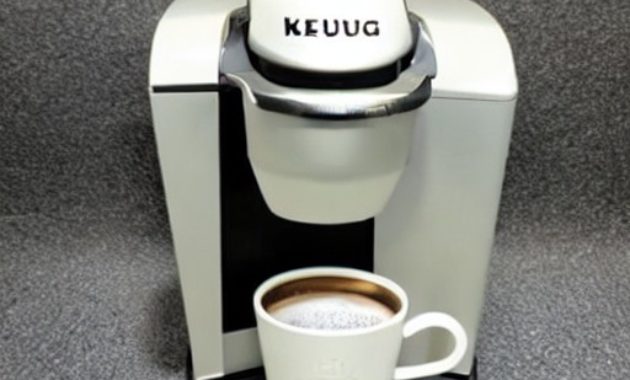
6. Clean all parts of the machine weekly, including the drip tray and K-Carafe
Keurig 2.0 brewers are a valuable part of most coffee drinkers’ mornings, but like any appliance, they can start to show signs of age and wear if not taken care of. In this post we’ll outline 10 tips for keeping your Keurig running smoothly all year long.
- Keep the machine clean – Periodically descale the water tank and K-Carafe by thoroughly rinsing them with clear water and pouring two cups of white vinegar into the water tank (or use a descaling solution made for K-Cups). Let the machine run on high pressure for six minutes; then turn it off and empty out the rinse bin. Finally, wipe down all parts with a damp cloth or kitchen towel
- Schedule regular maintenance – Make an appointment with your local Keurig dealer or contact us at 1-800-382-4279 to get service performed on your machine during its regularly scheduled time slot
- Change filters as needed – Every three months or 12000 brews, whichever comes first
- Use fresh beans every time – Store whole beans in an airtight container in the refrigerator for up to two weeks after grinding them fresh
- Clean and oil removable parts frequently – The drip tray, hopper assembly (front/back), carafe lid handle, power button
7. Keep your coffee grounds out of your machine by storage in an airtight container
Keurig 2.0 brewers are incredibly popular, with over 25 million units sold in the last four years alone. But like all machines, Keurigs need regular maintenance to run smoothly. Here are 10 tips to keep your machine running smoothly:
- Grind your coffee beans just before you brew them – this will help reduce the amount of coffee grounds that end up inside the machine
- Regular descaling will prevent build-up of coffee Grounds inside the machine – Follow these simple steps to descale your Keurig: Unplug your brewer by pushing down on the button located on the front of it for about two seconds until it makes a “ting” noise. Wait five minutes and plug it back in, then press and hold down both buttons at once for three seconds. Release both buttons and wait another five minutes. Repeat this process every six months
- Keep your coffee beans fresh by storing them in an airtight container – It’s best not to store Coffee Beans near heat or moisture sources
8. Don’t use chlorinated orhard water
Keurig 2.0 brewers use chlorinated water to produce coffee. While this method of brewing is convenient, it can damage your machine if the water contains too much chlorine. Chlorine also reacts with minerals in hard water to form deposits that can clog up your filters and make it difficult to use the machine smoothly. Don’t overfill your reservoir. Coffee will slowly seep into cracks and crevices in the tank, leading to a gradual loss of coffee and eventual failure of the machine Don’t put the machine in the dishwasher. The heat from dishwashers can destroy delicate parts inside machines
Keeping your Keurig 2.0 running smoothly is important for two main reasons. First, it preserves the machine’s lifespan and second, it avoids any potential damage that may occur as a result of poor water quality. By following these tips, you can keep your machine performing at its best and help to preserve your coffee budget in the process!
